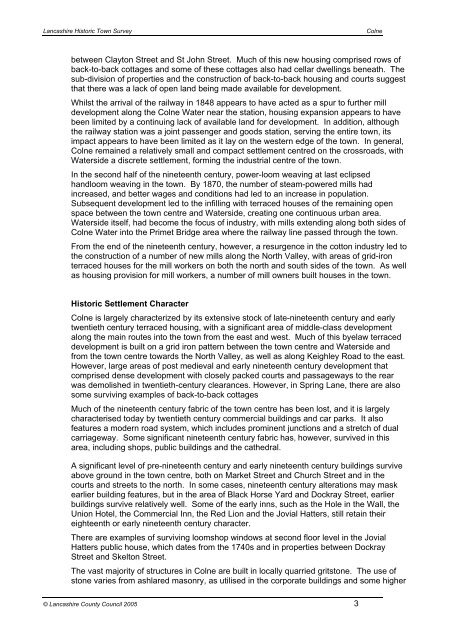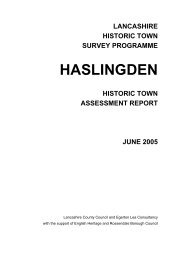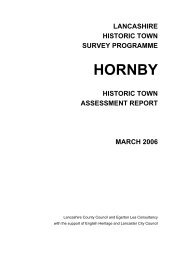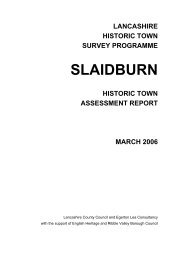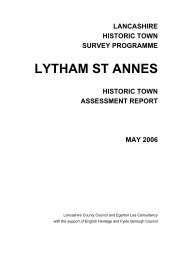Colne - Lancashire County Council
Colne - Lancashire County Council
Colne - Lancashire County Council
Create successful ePaper yourself
Turn your PDF publications into a flip-book with our unique Google optimized e-Paper software.
<strong>Lancashire</strong> Historic Town Survey<strong>Colne</strong>between Clayton Street and St John Street. Much of this new housing comprised rows ofback-to-back cottages and some of these cottages also had cellar dwellings beneath. Thesub-division of properties and the construction of back-to-back housing and courts suggestthat there was a lack of open land being made available for development.Whilst the arrival of the railway in 1848 appears to have acted as a spur to further milldevelopment along the <strong>Colne</strong> Water near the station, housing expansion appears to havebeen limited by a continuing lack of available land for development. In addition, althoughthe railway station was a joint passenger and goods station, serving the entire town, itsimpact appears to have been limited as it lay on the western edge of the town. In general,<strong>Colne</strong> remained a relatively small and compact settlement centred on the crossroads, withWaterside a discrete settlement, forming the industrial centre of the town.In the second half of the nineteenth century, power-loom weaving at last eclipsedhandloom weaving in the town. By 1870, the number of steam-powered mills hadincreased, and better wages and conditions had led to an increase in population.Subsequent development led to the infilling with terraced houses of the remaining openspace between the town centre and Waterside, creating one continuous urban area.Waterside itself, had become the focus of industry, with mills extending along both sides of<strong>Colne</strong> Water into the Primet Bridge area where the railway line passed through the town.From the end of the nineteenth century, however, a resurgence in the cotton industry led tothe construction of a number of new mills along the North Valley, with areas of grid-ironterraced houses for the mill workers on both the north and south sides of the town. As wellas housing provision for mill workers, a number of mill owners built houses in the town.Historic Settlement Character<strong>Colne</strong> is largely characterized by its extensive stock of late-nineteenth century and earlytwentieth century terraced housing, with a significant area of middle-class developmentalong the main routes into the town from the east and west. Much of this byelaw terraceddevelopment is built on a grid iron pattern between the town centre and Waterside andfrom the town centre towards the North Valley, as well as along Keighley Road to the east.However, large areas of post medieval and early nineteenth century development thatcomprised dense development with closely packed courts and passageways to the rearwas demolished in twentieth-century clearances. However, in Spring Lane, there are alsosome surviving examples of back-to-back cottagesMuch of the nineteenth century fabric of the town centre has been lost, and it is largelycharacterised today by twentieth century commercial buildings and car parks. It alsofeatures a modern road system, which includes prominent junctions and a stretch of dualcarriageway. Some significant nineteenth century fabric has, however, survived in thisarea, including shops, public buildings and the cathedral.A significant level of pre-nineteenth century and early nineteenth century buildings surviveabove ground in the town centre, both on Market Street and Church Street and in thecourts and streets to the north. In some cases, nineteenth century alterations may maskearlier building features, but in the area of Black Horse Yard and Dockray Street, earlierbuildings survive relatively well. Some of the early inns, such as the Hole in the Wall, theUnion Hotel, the Commercial Inn, the Red Lion and the Jovial Hatters, still retain theireighteenth or early nineteenth century character.There are examples of surviving loomshop windows at second floor level in the JovialHatters public house, which dates from the 1740s and in properties between DockrayStreet and Skelton Street.The vast majority of structures in <strong>Colne</strong> are built in locally quarried gritstone. The use ofstone varies from ashlared masonry, as utilised in the corporate buildings and some higher© <strong>Lancashire</strong> <strong>County</strong> <strong>Council</strong> 2005 3


